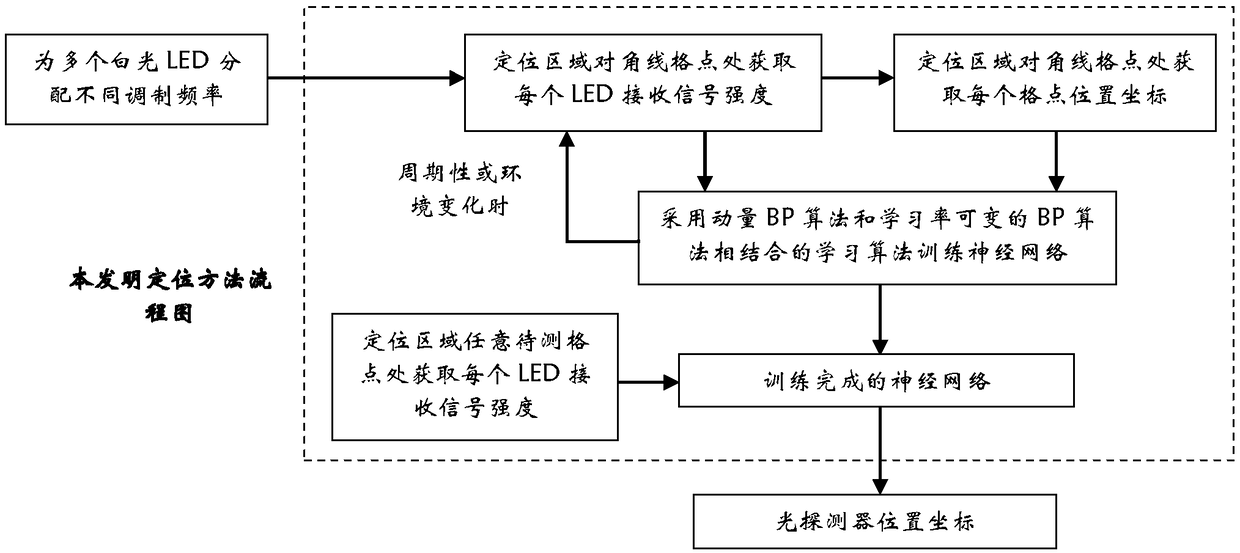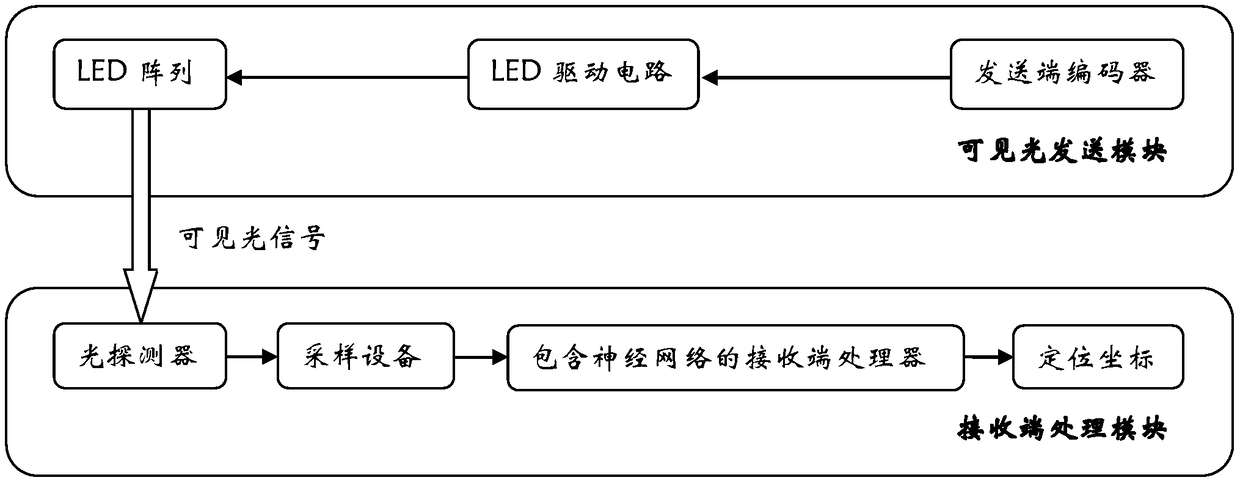Indoor visible light positioning method based on neural network and received signal intensity
A technology of received signal strength and neural network, applied in the field of indoor visible light positioning, can solve the problems of huge amount of sampled data, insufficient optimization of neural network algorithm for positioning accuracy, and low operation speed
- Summary
- Abstract
- Description
- Claims
- Application Information
AI Technical Summary
Problems solved by technology
Method used
Image
Examples
Embodiment 1
[0086] The present embodiment has described the flowchart of the method of the present invention, as attached figure 1 shown, including the following steps:
[0087] Step A assigns different modulation frequencies to multiple white LEDs;
[0088] Step B: obtain the received signal strength of each LED at the diagonal grid point of the positioning area;
[0089] Step C: Obtain the position coordinates of each grid point at the diagonal grid point of the positioning area;
[0090] Step D adopts the learning algorithm combining the momentum BP algorithm and the variable learning rate BP algorithm to train the neural network to obtain the trained neural network;
[0091] In order to obtain precise positioning effects, the training of the neural network needs to be repeated periodically or when the environment changes;
[0092] Step E: Obtain the received signal strength of each LED at any grid point to be measured in the positioning area, and input the trained neural network in...
Embodiment 2
[0095] Embodiment 2 provides a positioning system constructed according to the "Indoor Visible Light Positioning Method Based on Neural Network and Received Signal Strength" of the present invention, as shown in the attached figure 2 shown. The positioning system mainly includes two parts: the visible light sending module and the receiving end processing module;
[0096] The visible light transmission module also includes three parts: the transmitter encoder, the LED drive circuit and the LED array;
[0097] Among them, the encoder at the sending end can be an FPGA or a single-chip microcomputer, and its function is to generate periodic signals of different frequencies sent by the white LEDs of the LED array. The frequency range of the periodic signals is 800Hz-4kHz, and 4 LEDs are used in the LED array;
[0098] Specifically in this embodiment, the encoder at the sending end uses FPGA, and 4 LEDs are used in the LED array, and the frequencies of the periodic signals sent by...
Embodiment 3
[0110] Embodiment 2 provides a specific scene for indoor positioning according to the "Indoor Visible Light Positioning Method Based on Neural Network and Received Signal Strength" of the present invention, as shown in the attached image 3 shown. The size of the indoor scene is 70cm╳70cm╳100cm, and the positioning area is 60cm╳60cm.
[0111] Specifically in this embodiment, Step 1 is refined as follows: install 4 white LED lights on the ceiling, and use on-off keying (00K) for frequency modulation, the frequency range is 800Hz-4kHz, and the modulation frequency is not a multiple of each other. 885Hz, 1725Hz, 2500Hz and 3125Hz, sending visible light signals vertically downward;
[0112] Specifically in this embodiment, step 2 is refined as follows: place photodiodes horizontally in the positioning area 1 meter below the ceiling; the positioning area is evenly divided into 49 grid points, wherein the distance between adjacent grid points is 10 cm; the neural network The train...
PUM
 Login to View More
Login to View More Abstract
Description
Claims
Application Information
 Login to View More
Login to View More - R&D
- Intellectual Property
- Life Sciences
- Materials
- Tech Scout
- Unparalleled Data Quality
- Higher Quality Content
- 60% Fewer Hallucinations
Browse by: Latest US Patents, China's latest patents, Technical Efficacy Thesaurus, Application Domain, Technology Topic, Popular Technical Reports.
© 2025 PatSnap. All rights reserved.Legal|Privacy policy|Modern Slavery Act Transparency Statement|Sitemap|About US| Contact US: help@patsnap.com



